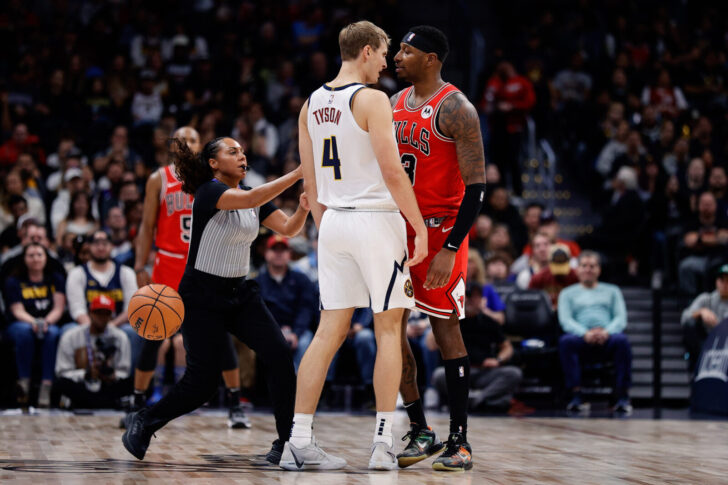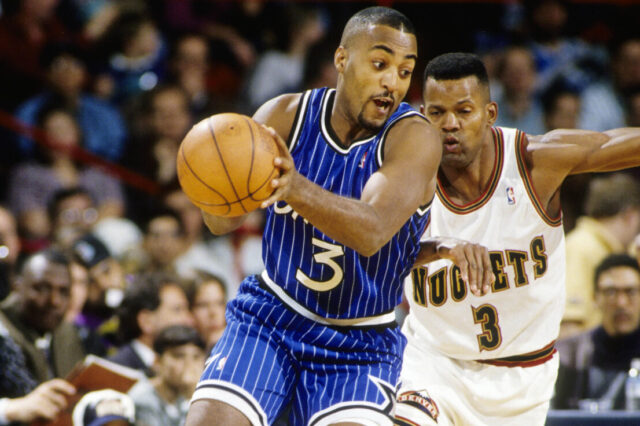How can a season with almost no playing time be judged? Hunter Tyson had the life that most second-rounders have on championship squads: towel-waver. Tyson was the odd-man out for Denver’s rotations this past season, logging just 48 minutes of NBA time despite a season-ending injury to forward Vlatko Cancar as well as the ineffectiveness of Zeke Nnaji for most of the season. When fellow rookie Julian Strawther went down with a knee injury, Tyson’s name was not called to fill in – despite shooting being his senior year calling card and presumably the thing that caused Calvin Booth to draft him. Figuring out what Tyson can offer going forward requires looking into the reasons he was unable to play this year, and what he can do about that in the future.
2023-2024 Season stats
| PPG | RPG | APG | SPG | FG% | 3PT% | VORP | BPM |
| 1.1 | 0.5 | 0.1 | 0.1 | 40.00% | 28.60% | -0.1 | -8.9 |
Season Story
Hunter Tyson was Denver’s third and final draft pick in the 2023 NBA draft, and had many people (including yours truly) asking: huh? Julian Strawther was a swingman with size and both a shooting stroke and a floater, so his future role was easy to see. Jalen Pickett had his own unique point-guard style for a team lacking a long-term backup at the position. Hunter Tyson was the third draftee and was given a 4-year deal by GM Calvin Booth, just as Jalen Pickett was. That meant there had to be a long-term plan for him, right? So what was it?
At Summer League the answer looked simple: rock-solid shooter and good rebounder with a lot of energy and emotion on both sides of the ball. He was named to the Summer League First Team squad with 20.8 points and 6 rebounds a game. The Nuggets even gave him his own Summer League highlight reel.
— Denver Nuggets (@nuggets) July 17, 2023
But this is why Summer League, where defense plays almost no role and scrappiness counts for as much as talent, is a hard place to judge NBA impact. In the few minutes that Tyson did get against NBA competition in the regular season, he looked undersized and ill-equipped to deal with either speed or physicality from his opponents, which is a bad place to be stuck in. The header image, incidentally, is him facing off with Torrey Craig and staring the 6’7 small forward directly in the eye.
And that was one of his biggest obstacles to playing this year: he is currently not a stretch 4 because he is not a power forward at all. He got shoved around the court against NBA big men, but didn’t have the footspeed to handle perimeter defense. Denver went with Justin Holiday as the emergency backup wing more and more as the season went on, because Holiday could play the 2 or the 3 and as a veteran he knew where to be on the court and how to handle physical play. Tyson was not given that chance because he had not earned it. He played well down in the G League in 17 games, scoring almost 24 points a game on 40.8% from behind the arc and grabbing 8 rebounds, but the G League is also not a league known for its defense. To earn his coach’s belief and get into the rotation, Tyson needs to fill a role for the bench in a way he was not able to this season.
’24/’25 outlook with the Nuggets
To get more court time for Denver in ’24-25, Hunter will have to resolve at least one side of his dilemma: get quicker or get stronger. Tyson is not going to get up 18 shots a game like he did in the G League. Christian Braun got 6, Justin Holiday had 3, and Peyton Watson had 5 for the bench. If there is one bench shooter it might be Strawther, whose minutes can be expected to rise, but he and Tyson are essentially the same size. Strawther was 6’6″ barefoot at the combine with a 6’9.25″ wingspan, while Tyson was 6’7.5″ with a 6’9.75″ wingspan. That’s Tyson’s real problem: if he can’t play power forward with any consistency, there’s no real avenue to minutes for him because Braun, Watson and Strawther all can play the shooting guard or Small Forward with better defense against smaller perimeter foes than Tyson has shown either in college or the pros.
Passion and effort are not enough. Hunter Tyson needs to spend his summer working out with Vlatko and getting swole. His height is not a barrier to him playing small-ball 4, and neither is his activity level – it’s his inability to stand on the block in the NBA and be successful. If he’s simply going to be a perimeter-based small forward who neither passes nor defends then the Nuggets have entrenched options, veteran options, and options drafted higher than him who can do that and more. The willingness to slide on the floor for steals or drive the lane through traffic for a finish is great, but it’s the dirty work that Denver needs done, not the highlight work.
The Nuggets gave Tyson a four-year contract with the idea that he can fill a bench role for them so that they don’t have to try to find a veteran to do it. He turns 24 this week. His offense has been his calling card so far in his basketball career, but he won’t get the chance to play it unless he can figure out how to do the things that will force coach Michael Malone to put him on the court in the first place. Defensive lapses won’t cut it. Being shoved around by bigger players and blitzed by smaller ones makes the wrong impression. Both in the film room and in the weight room, Hunter Tyson has to put in the work this offseason to let the team see him as more than a towel-waver – or both he and the Nuggets will be the worse for it.



